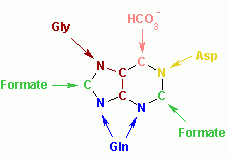Nucleotide
Nucleotides are organic compounds that consist of three joined structures: a nitrogenous base, a sugar, and a phosphate group. In addition to forming the structural units of RNA and DNA, nucleotides are sources of chemical energy in metabolism (adenosine triphosphate and guanosine triphosphate), are incorporated into important cofactors in enzymatic reactions (coenzyme A, flavin adenine dinucleotide, flavin mononucleotide, and nicotinamide adenine dinucleotide phosphate), and have roles in cellular signaling (cyclic guanosine monophosphate).
Contents |
Nucleotide structure

A nucleotide is composed of a nitrogenous base, a five carbon sugar (either ribose or deoxyribose), together referred to as a nucleoside and one to three phosphate groups attached to either the 2, 3, or most usually 5-carbon of the sugar. Cyclic nucleotides possess a phosphate group bound to two of the sugar's hydroxyl groups. Nucleotides can be synthesized through a variety of methods both in vitro and in vivo. This can involve salvage synthesis (the re-use of parts of nucleotides in resynthesizing new nucleotides through breakdown and synthesis reactions in order to exchange useful parts), or the use of protecting groups in a laboratory. In the latter case, a purified nucleoside or nucleobase is protected to create a phosphoramidite, and can be used to obtain analogues not present in nature and/or to create an oligonucleotide.
The first step of nucleotide synthesis is the formation of a nucleoside (the nitrogenous base joined to a sugar). The sugar involved in the synthesis and structure of a nucleotide may be either ribose or deoxyribose; in the latter case, the prefix 'deoxy' may be added before the name of the nucleoside in all cases except Uracil. A functional group of phosphate is then esterified to the sugar, creating a nucleotide. The phosphate group may consist of one, two, or three phosphates, forming monophosphates, diphosphates, or triphosphates, respectively.
Synthesis
Nucleotides can be synthesized through a variety of methods both in vitro and in vivo. This can involve salvage synthesis (the re-use of parts of nucleotides in resynthesizing new nucleotides through breakdown and synthesis reactions in order to exchange useful parts), or the use of protecting groups in a laboratory. In the latter case, a purified nucleoside or nucleobase is protected to create a phosphoramidite, and can be used to obtain analogues not present in nature and/or to create an oligonucleotide.
Types of bases
Nucleotides can be synthesized with both purine and pyrimidine as bases. In DNA, the purine bases are adenine and guanine, while the pyrimidines are thymine and cytosine. RNA uses uracil rather than thymine (thymine is produced by adding a methyl to uracil). The nucleotide passes through numerous biochemical steps while being processed, adding and removing atoms through the use of numerous enzymes.
Pyrimidine ribonucleotides

The synthesis of a single pyrimidine is complex; the diagram to the left demonstrates the synthesis of a single pyrimidine.
Purine ribonucleotides
The atoms which are used to build the purine nucleotides come from a variety of sources:
 |
The biosynthetic origins of purine ring atoms N1 arises from the amine group of Asp C2 and C8 originate from formate N3 and N9 are contributed by the amide group of Gln C4, C5 and N7 are derived from Gly C6 comes from HCO3- (CO2) |

The de novo synthesis of purine nucleotides by which these precursors are incorporated into the purine ring, proceeds by a 10 step pathway to the branch point intermediate IMP, the nucleotide of the base hypoxanthine. AMP and GMP are subsequently synthesized from this intermediate via separate, two step each, pathways. Thus purine moieties are initially formed as part of the ribonucleotides rather than as free bases.
Six enzymes take part in IMP synthesis. Three of them are multifunctional:
- GART (reactions 2, 3, and 5)
- PAICS (reactions 6, and 7)
- ATIC (reactions 9, and 10)
Reaction 1. The pathway starts with the formation of PRPP. PRPS1 is the enzyme that activates R5P, which is primarily formed by the pentose phosphate pathway, to PRPP by reacting it with ATP. The reaction is unusual in that a pyrophosphoryl group is directly transferred from ATP to C1 of R5P and that the product has the α configuration about C1. This reaction is also shared with the pathways for the synthesis of the pyrimidine nucleotides, Trp, and His. As a result of being on (a) such (a) major metabolic crossroad and the use of energy, this reaction is highly regulated.
Reaction 2. In the first reaction unique to purine nucleotide biosynthesis, PPAT catalyzes the displacement of PRPP's pyrophosphate group (PPi) by Gln's amide nitrogen. The reaction occurs with the inversion of configuration about ribose C1, thereby forming β-5-phosphorybosylamine (5-PRA) and establishing the anomeric form of the future nucleotide. This reaction which is driven to completion by the subsequent hydrolysis of the released PPi, is the pathway's flux generating step and is therefore regulated too.
See also
- Chromosome
- Gene
- Genetics
- Nucleic acid analogues
External links
- Abbreviations and Symbols for Nucleic Acids, Polynucleotides and their Constituents (IUPAC)
- Provisional Recommendations 2004 (IUPAC)
- Chemistry explanation of nucleotide structure
|
|||||||||||||||||||||||||||